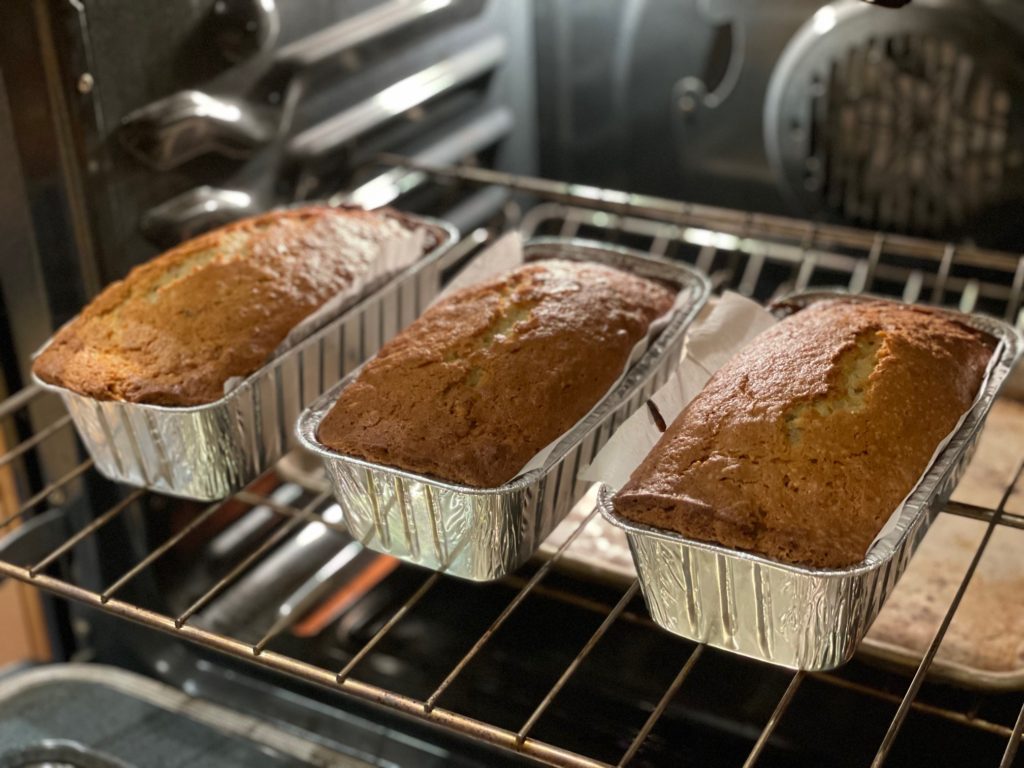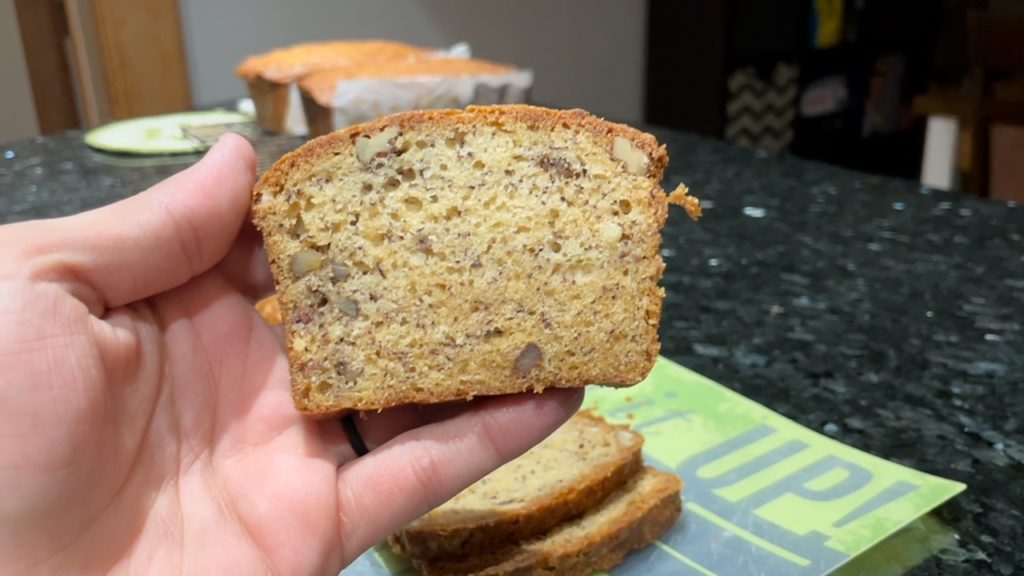
A few weeks ago, my mom sent me her award-winning banana bread recipe. I was excited to try the recipe and recreate the banana bread of my childhood. Well, in a rush to get the bread baking, I accidentally added 1 1/4 cups of buttermilk instead of the mere 1/4 cup that the recipe called for. So, the batter was far more runny and wet than it should have been. But, the banana bread turned out perfectly fine anyway! That led me to do a little experiment where I tested three different banana bread formulas to find the perfect batter consistency. The results of the experiment are below, but here’s the question you probably came here for – what consistency should banana bread batter be?
As a general rule, banana bread batter should be a little bit thicker than pancake batter but not nearly as thick as cookie dough. If you take a spoonful of batter, most of the batter should pour off of the spoon easily. A thicker batter will produce a drier and more crumbly banana bread, while a thinner batter will produce a softer and more moist banana bread. You can make the batter thinner by adding a few tablespoons of milk or water, and you can make the batter thicker by adding a few more tablespoons of flour.
In the rest of this article, I’ll show you how I made a thick-batter banana bread, a medium-batter banana bread, and a thin-batter banana bread. You’ll get to see the result of each loaf, and I’ll explain what effect the level of moisture had on the texture of each final product. Let’s get started with the one simple banana bread recipe formula I followed.
My Batter Experiment – Banana Bread Made Three Ways

The following is the exact banana bread recipe that I followed for each of the three loaves for this experiment. I used this same base recipe and changed the level of moisture in each loaf by altering the amount of buttermilk. There was a 1/4 cup of buttermilk in the thick batter, a 1/2 cup in the medium batter, and 3/4 cup in the thin batter. The amount of buttermilk in each recipe was the only variable.
| Thick-Batter Banana Bread | Medium-Batter Banana Bread | Thin-Batter Banana Bread |
|---|---|---|
| WET INGREDIENTS Buttermilk – 1/4 cup Vegetable Oil – 1/2 cup Sugar – 1 cup Bananas – 2 medium Eggs – 1 medium DRY INGREDIENTS All Purpose Flour – 1 1/2 cups Salt – 1/4 tsp Baking Soda – 1/2 tsp Chopped Walnuts – 1/4 cup | WET INGREDIENTS Buttermilk – 1/2 cup Vegetable Oil – 1/2 cup Sugar – 1 cup Bananas – 2 medium Eggs – 1 DRY INGREDIENTS All Purpose Flour – 1 1/2 cups Salt – 1/4 tsp Baking Soda – 1/2 tsp Chopped Walnuts – 1/4 cup | WET INGREDIENTS Buttermilk – 3/4 cup Vegetable Oil – 1/2 cup Sugar – 1 cup Bananas – 2 medium Eggs – 1 DRY INGREDIENTS All Purpose Flour – 1 1/2 cups Salt – 1/4 tsp Baking Soda – 1/2 tsp Chopped Walnuts – 1/4 cup |
Mixing and Baking Process
For each loaf I mixed the wet ingredients together first, and then I added the dry ingredients on top of that. Then I mixed everything thoroughly to combine. For one of the loaves, I forgot to add the buttermilk until after the dry ingredients were already added. I figured this probably didn’t make much, if any, difference in the final product. Then after the wet and dry ingredients were mixed, I folded in the walnuts with a spatula.
I then poured each batter into a 2-pound aluminum bread pan. All three loaves were baked in the same pre-heated oven for 60 minutes at 350°F.

Here is how each of the individual loaves turned out.
Thick-Batter Banana Bread

For the thicker banana bread batter, I chose to use a relatively low amount of liquid: 1/4 cup of buttermilk. Because the mashed bananas, eggs, and oil, also provide moisture when you’re making quick breads, banana bread technically doesn’t require a lot of additional liquid. So, I was excited to see what result I would get from just a small amount of buttermilk.
The banana bread made with thick batter ended up being slightly dry, in my opinion. The loaf also felt very solid and sturdy before cutting into it.

The walnuts had a pretty good distribution throughout this loaf. In the majority of slices the walnuts were dispersed evenly throughout, not clumping up on the bottom or on the sides.

And even though this bread was on the drier side, the sweet banana flavor came through very well and I thought it was a pretty tasty loaf of banana bread. Now, for the medium-batter banana bread.
Medium-Batter Banana Bread

For the medium-batter banana bread, I decided to add a 1/2 cup of buttermilk. That’s twice the amount of liquid as the thick-batter version. Since typical banana bread recipes can vary a lot, I wanted to see what the results would be in this experiment with various levels of liquid.
The medium-batter banana bread was definitely more spongy to the touch (in a good way). When I held the loaf in my hands before cutting it, it had a slight bounce to it and didn’t feel as dense as the first loaf.

When I tasted the medium-batter banana bread, I immediately noticed the difference in moisture content. This loaf was not as dry as the first one, and the moisture made a big difference. It felt like this loaf was made by a grandma who knows what they’re doing, compared to the dry loaf, which now felt sort of like a college kid who made banana bread for the first time. So, my perception of the thick-batter loaf definitely changed upon tasting the medium-batter loaf. I liked this one a lot better.
The walnuts had a good distribution throughout this loaf too, and they didn’t clump up in any weird places. The taste was even better than the thick-batter loaf, with the sweet banana flavor coming through very well, balanced by the subtle acidity and moistness from the buttermilk.
Now, let’s see how the thin-batter banana bread turned out. Will even more moisture be better?
Thin-Batter Banana Bread

For the thin-batter banana bread, I added 3/4 cups of buttermilk to the batter. This created the wettest batter that I used for this experiment. The resulting loaf of banana bread was even more moist than the medium-batter version!
When I held the loaf before slicing it, I could tell that it was going to be very moist on the inside. I even worried a little bit that it might still be gooey in the middle. Although, I did take the internal temperature of each loaf with a probe thermometer, and they all measured about 200°F, so I was pretty sure this one would be OK. If you want to get a probe thermometer for yourself, I find them very helpful for checking the temperature of my breads and quick breads. Get your own thermometer on Amazon here.

When I cut into the loaf, the first thing I noticed was that it wasn’t gooey in the middle at all. Thanks, thermometer! The walnuts didn’t all sink to the bottom either. That’s what everyone always worries about with a thin quick-bread batter, so I was very happy that this didn’t happen to me. The walnuts were very well distributed throughout each slice.
It was very bouncy to the touch before I sliced into it, and the interior of the loaf was also super moist. Although it’s technically unrelated, the moistness of each slice of this banana bread seemed to bring out extra banana flavor. Somehow the moistness played extremely well with the sweetness of the bananas.

So, Which Banana Bread Did I Like Best?
I personally liked the thin-batter banana bread the best. As a fan of moist quick breads, the texture of this one was definitely my favorite, and honestly, the banana flavor seemed to be the best too. But, if you like a more crumbly banana bread, the thick-batter version might be more your preference.
Between the medium-batter version and the thin-batter version, there wasn’t that much difference in flavor. The moisture content is what stood out to me the most. However, the thin-batter loaf was a little more difficult to handle before I cut it. Everything just felt more delicate and I was worried I was going to break the loaf with my hands. So, I can see how a commercial bakery might want to shoot for something in the middle to balance flavor/moisture with production/handling. But for a home baker, it’s going to be the thin-batter banana bread from now on in my house!
If you liked this experiment and want to make your own banana bread at home, you can follow the recipe and process I mentioned above. You can also check out the Sourdough Discard Banana Bread Recipe that I posted on my YouTube channel.
